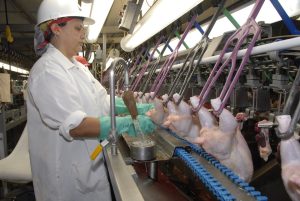 By Brandon Martin
By Brandon Martin
Like the rest of the south, most people in Southside Virginia grew up on a diet of meat and potatoes. This rugged lifestyle of rural statesmen has stood the test of time, but in the creeping “new normal” of life under coronavirus (COVID-19), social distancing guidelines could begin to affect our protein counts.
In Virginia, the state’s 10 poultry factories had 128 positive COVID-19 cases resulting in two deaths out of 7,072 total workers, according to data collected by the Center for Disease Control and Prevention (CDC).
Before a May 6 briefing, Gov. Ralph Northam, D-Va., received a letter from a coalition consisting of the Legal Aid Justice Center, Virginia Organizing, and Community Solidarity for Poultry Workers, to enact enforceable COVID-19-specific measures for poultry plants and farms across Virginia.
“More than ten thousand workers working in the Valley’s plants are similarly suffering, worrying, and, in some instances, dying due to COVID-19,” the coalition said, adding that they have yet to see “anything issued beyond recommendations, many of which seem untenable or shift the burden to the workers, and none of which can be enforced if the employer does not follow them.”
Testing is currently available at 10 sites on Virginia’s portion of the Eastern Shore, but factories in the Shenandoah Valley have not seen a similar response.
Overall, the coalition is asking for the State Board of Health and Northam to use their authority to have the Virginia Occupational Safety and Health produce enforceable regulations on worker safety. This would extend to social distancing, sanitizing, disinfection, protective equipment requirements, mandatory notifications to the Virginia Department of Health, whistleblower protections, mandatory shutdowns for sanitizing following a positive test, and mandatory testing for COVID-19.
In addition, the coalition wants the General Assembly to pass new legislation for paid leave for employers with more than 500 employees, which would include almost all poultry plants.
According to the same CDC data, COVID-19 cases among U.S. workers in 115 meat and poultry processing facilities were reported by 19 states. Among approximately 130,000 workers at these facilities, 4,913 cases and 20 deaths occurred.
Secretary of Agriculture Sonny Perdue has directed all processing facilities to take all appropriate actions to continue operations consistent with the guidance jointly issued by the CDC and the U.S. Department of Labor’s (DOL) Occupational Safety and Health Administration (OSHA) regarding public health and worker safety.
“I understand that State and local leaders are working diligently to protect and maintain the wellbeing of their citizens, including those who work on the front lines in critical industries, such as meat and poultry processing,” he said. “It is essential that we work together to ensure the health and safety of those who help keep food on the table during this unprecedented time.”
During the study published by the CDC, the processing facilities were at risk due to the inability to effectively “maintain a 6-foot (2-meter) distance while working.”
In addition to the production lines, nonproduction settings during breaks and while entering and exiting facilities were also seen as problem areas.
“The pace and physical demands of processing work made adherence to face-covering
recommendations difficult, with some workers observed covering only their mouths and frequently readjusting their face coverings while working,” the report continued.
The study also found that some sites had difficulty adhering to the heightened cleaning and disinfection guidance recommended for all worksites to reduce COVID-19 transmission.
The facilities implemented a number of strategies to minimize transmission, such as adjusting start and stop times of shifts and breaks to increase physical distance between workers. Outdoor break areas were added at some facilities to decrease contact between workers while some facilities installed plexiglass barriers between workers; however, this was not practical for all worker functions. Symptom and temperature screening of workers was newly instituted in some facilities and improved in others as well.
Not only did the facility provide barriers to safe COVID-19 practices, but so did a cultural and economic breakdown of the workers. Most of the plants hire employees from a variety of ethnic backgrounds leading to a number of different languages spoken in the workplace, with one factory reporting 40 different languages.
Training on “what workers should do when they feel ill before or at work, symptoms of COVID-19, medical leave policies, social distancing recommendations, correct donning and doffing of PPE and face coverings, hand hygiene practices, opportunities to access testing as it becomes more widely available, and potential routes of transmission at work and in the community,” should be provided by culturally competent trainers, in a setting where social distancing can be maintained, in languages spoken by workers and with consideration given to varying levels of education, according to the CDC.
Many of the factory workers also lived in crowded, multigenerational settings, sometimes sharing transportation to and from work which contributed “to increased risk for transmission of COVID-19 outside the facility itself.”
The CDC recommends changing transportation to and from the facilities to increase the number of vehicles and reduce the number of passengers per vehicle to help maintain physical distancing in some facilities.
In addition, some employees were incentivized to work while ill as a result of medical leave and disability policies and attendance bonuses that could encourage working while experiencing symptoms. Similarly, the CDC recommends reformation in these areas.
Photo courtesy of the USDA/Alice Welch




